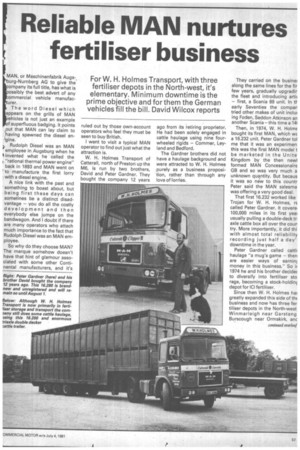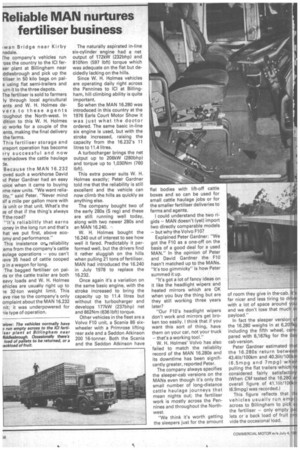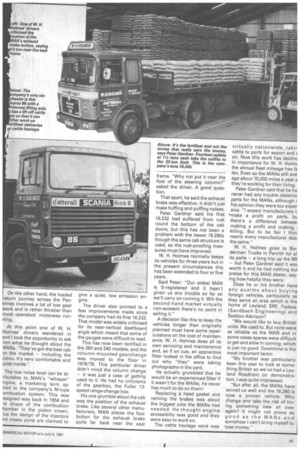Reliable MAN nurtures fertiliser business
Page 33

Page 34

Page 35

If you've noticed an error in this article please click here to report it so we can fix it.
MAN, or Maschinenfabrik Augs-, urg-Nurnberg AG to give the ompany its full title, has what is ossibly the best advert of any ommercial vehicle manufacurer.
The word Diesel which appears on the grills of MAN rehicles is not just an example f superfluous badging. It points put that MAN can lay claim to having spawned the diesel en Rudolph Diesel was an MAN employee in Augsburg when he invented what he called the "rational thermal power engine" back in 1893 and MAN went on ' to manufacture the first lorry with a diesel engine.
A nice link with the past and something to boast about, but being first these days can sometines be a distinct disadvantage — you do all the costly development and then everybody else jumps on the bandwagon. And I doubt if there are many operators who attach much importance to the fact that Rudolph Diesel was an MAN employee.
So why do they choose MAN? The marque somehow doesn't have that hint of glamour associated with some other Continental manufacturers, and it's ruled out by those own-account operators who feel they must be seen to buy British.
I went to visit a typical MAN operator to find out just what the attraction is.
W. H. Holmes Transport of Catterall, north of Preston up the M6, is run by two brothers, David and Peter Gardner. They bought the company 12 years ago from its retiring proprietor. He had been solely engaged in cattle haulage using nine fourwheeled rigids — Commer, Leyland and Bedford.
The Gardner brothers did not have a haulage background and were attracted to W. H. Holmes purely as a business proposition, rather than through any love of lorries. They carried on the businer along the same lines for the fir few years, gradually upgradir the fleet and introducing artir — first, a Scania 89 unit. In early Seventies the compar tried other makes of unit inclur ing Foden, Seddon Atkinson an another Scania —this time a 141 Then, in 1974, W. H. Holm bought its first MAN, which we a 16.232 unit. Peter Gardner tol me that it was an experimen this was the first MAN model t be marketed in the Unite Kingdom by the then newl formed MAN Concessionaire GB and so was very much a unknown quantity. But becaus it was so new to this countr Peter said the MAN salesma was offering a very good deal.
That first 16.232 worked like Trojan for W. H. Holmes, rE called Peter Gardner. It cover°. 100,000 miles in its first yew usually pulling a double-deck tri axle cattle box all over the cow, try. More importantly, it did thi with almost total reliability recording just half a day' downtime in the year.
Peter Gardner called cattli haulage "a mug's game — then are easier ways of earninc, money in this business." So ir 1974 he and his brother decide( to diversify into fertiliser sto rage, becoming a stock-holdinc depot for ICI fertiliser.
Since then W. H. Holmes ha: greatly expanded this side of thE business and now has three fer tiliser depots in the North-west Winmarleigh near Garstang Burscough near Ormskirk, anc 'wan Bridge near Kirby nsdale.
fhe company's vehicles run -oss the country to the ICI ferser plant at Billingham near ddlesbrough and pick up the :Miser in 50 kilo bags on pals using flat semi-trailers and .urn it to the three depots.
The fertiliser is sold to farmers ly through local agricultural ents and W. H. Holmes devers to these agents -oughout the North-west. In dition to this W. H. Holmes ;o works for a couple of the ents, making the final delivery the farms.
This fertiliser storage and insport operation has become )ry successful and now rershadows the cattle haulage le.
Because the MAN 16.232 oved such a workhorse David id Peter Gardner had an easy ioice when it came to buying ime new units. "We want reliality," said Peter. "Never mind 3If a mile per gallon more with is unit or that unit. What's the 3e of that if the thing's always 1 the road?
"It's reliablitly that earns ioney in the long run and that's hat we put first, above ecoorny and performance."
This insistence on. reliability :ems from the company's cattle aulage operations — you can't ave 35 head of cattle cooped p in a wagon for long.
The bagged fertiliser on palits or the cattle trailer are both eavy loads and W. H. Holmes ehicles are usually right up to le 32-ton weight limit. This aye rise to the company's only omplaint about the MAN 16.232 nit; it was underpowered for us type of operation. The naturally aspirated in-line six-cylinder engine had a net output of 172kW (232bhp) and 810Nm (597 lbft) torque which was adequate on the flat but decidedly lacking on the hills.
Since W. H. Holmes vehicles are operating daily right across the Pennines to ICI at Billingham, hill climbing ability is quite important.
So when the MAN 16.280 was introduced in this country at the 1976 Earls Court Motor Show it was just what the doctor ordered. The same basic in-line six engine is used, but with the stroke increased, raising the capacity from the 16.232's 11 litres to 11.4 litres.
A turbocharger brings the net output up to 206kW (280bhp) and torque up to 1,030Nm (760 lbft).
This extra power suits W. H. Holmes exactly; Peter Gardner told me that the reliability is still excellent and the vehicle can now climb the hills as quickly as anything else.
The company bought two of the early 280s (S reg) and these are still running well today, along with two newer 280s and an MAN 16.240, W. H. Holmes bought the 16.240 out of interest to see how well it fared. Predictably it performed well, but the drivers find it rather sluggish on the hills when pulling 21 tons of fertiliser. MAN had introduced the 16.240 in July 1978 to replace the 16.232.
Once again it's a variation on the same basic engine, with the stroke increased to bring the capacity up to 11.4 litres but without the turbocharger and develops 177kW (237bhp) net and 862Nm (636 lbft) torque.
Other vehicles in the fleet are a Volvo F10 unit, a Scania 86 sixwheeler with a Primrose lifting rear axle and a Seddon Atkinson 200 16-tonner. Both the Scania and the Seddon Atkinson have flat bodies with lift-off cattle boxes and so can be used for small cattle haulage jobs or for the smaller fertiliser deliveries to farms and agents.
I could understand the two rigids — MAN doesn't (yet) import two directly comparable models — but why the Volvo F10?
Explained Peter Gardner: "We got the F10 as a one-off on the basis of a good deal for a used MAN." In the opinion of Peter and David Gardner the F10. hasn't matched up to the MANs. "It's too gimmicky" is how Peter summed it up.
"It's got a lot of fancy ideas on it like the headlight wipers and heated mirrors which are OK when you buy the thing but are they still working three years later?
"Our F10's headlight wipers don't work and mirrors get broken too easily. 1 think that if you want this sort of thing, have them on your car, not your truck — that's a working tool."
W. H. Holmes' Volvo has also failed to match the reliablity record of the MAN 16.280s and its downtime has been significantly greater, reported Peter.
The company always specifies the sleeper-cab versions on the MANs even though it's only the small number of long-distance cattle haulage journeys that mean nights out; the fertiliser work is mostly across the Pennines and throughout the Northwest.
"We think it's worth getting the sleepers just for the amount
of room they give in the,cab. !els far nicer and less tiring to driv with a lot of space around you and we don't lose that much ip payload."
In fact the sleeper version of the 16.280 weighs in at 6,207kg including the fifth wheel, compared with 6,167kg for the day cab version.
Peter Gardner estimated that the 16.280s return between 43.41it/100km and 40.31it/1001qn (6.5mpg and 7mpg) whomn pulling the flat trailers which he considered fairly satisfactorii, (When CM tested the 16.280 ir overall figure of 41.11it/100krr (6.9mpg) was recorded.)
This figure reflects that thE vehicles usually run empt) across to Billingham to pick 14 the fertiliser — only empty pal lets or a back load of fruit pro vide the occasional load. On the other hand, the loaded return journey across the Penpines involves a lot of low gear work and is rather thirstier than most operators motorway running.
At this point one of W. H. Holmes' drivers wandered in and I took the opportunity to ask iim what he thought about the VlANs. "They've got the best cab )n the market — including the Jolvo. It's very comfortable and luiet inside."
The low noise level can be atributable to MAN's 'whisper" !ngine, a marketing term apdied to the company's M-type ombustion system. This was esigned way back in 1954 and le shape of the combustion hamber in the piston crown, lus the design of the injectors nd intake ports are claimed to give a quiet, low emission en gine.
The driver also pointed to a few improvements made since the company had its first 16.232. That model was widely criticised for its near-vertical dashboard angle which meant that some of the gauges were difficult to read.
This has now been rectified in the 280 and 240 models, and the column-mounted gearchange was moved to the floor in 1978/79. This particular driver didn't mind the column change — it was just a case of getting used to it. He had no criticisms of the gearbox, the Fuller 13speed range-change box.
His one grumble about the cab was the position of the exhaust brake. Like several other manufacturers, MAN places the foot button for the exhaust brake quite far back near the seat frame. "Why not put it near the foot of the steering column?" asked the driver. A good question.
That apart, he said the exhaust brake was effective; it didn't just make huffing and puffing noises.
Peter Gardner said his first 16.232 had suffered from rust round the bottom of the cab doors, but this has not been a problem with the newer 16.280s though the same cab structure is used, so the rust-proofing measures must have improved.
W. H. Holmes normally keeps its vehicles for three years but in the present circumstances this has been extended to four or five years.
Said Peter: "Our oldest MAN is S-registered and it hasn't given us any trouble so far so we'll carry on running it. Wih the second-hand market virtually non-existent there's no point in selling it."
A decision like this to keep the vehicles longer than originally planned must have some repercussions on the cost of maintenance. W. H. Holmes does all its own servicing•and maintenence and, as if on cue, an apprentice fitter looked in the office to find out why "they" were taking photographs in the yard.
He actually grumbled that he would be an experienced fitter if it wasn't for the MANs; he never has much to do on them!
Replacing a head gasket and relining the brakes was about the biggest jobs the MANs had needed. He thought engine accessibilty was good and they were easy to work on.
The cattle haulage work was
virtually nationwide, takir cattle to ports for export and E
on. Now this work has declin€
in importance for W. H. Holm the annual fleet mileage has fa
len. Even so the MANs still ave age about 70,000 miles a year s they're working for their living.
Peter Gardner said that he ha never had any trouble obtainin parts for the MANs, although i his opinion they were too exper sive. "I expect manufacturers t, • make a profit on parts, bu there's a difference betweei making a profit and making killing. But to be fair I thini nearly every manufacturer doe: the same."
W. H. Holmes goes to Bor derman Trucks in Penrith for al its parts — a long trip up the ME — but Peter Gardner said it waE worth it and he had nothing bui praise for this MAN dealer, saying how helpful they were.
Does he or his brother have any qualms about buying foreign vehicles, particularly as they serve an area which is the home of Leyland, ERF, Fodens (Sandbach Engineering) and Seddon Atkinson?
"We would like to buy British units. We used to. But none were as reliable as the MAN and in some cases spares were difficult to get and slow in coming, which is just no good. Downtime is the most important factor.
"My brother was particularly keen this year to look at something British so we've had a Leyland Roadtrain on demonstration. I was quite impressed.
"But after all, the MANs have served us well and the 16.280 is now a proven vehicle. Why change and take the risk of trying something new all over again? It might not prove as good as the MANs and somehow I can't bring myself to lose money."












































